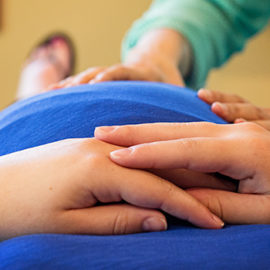One problem that many pregnant women complain about is pubic pain. Yet doctors and midwives often dismiss pelvic pain in pregnancy as either “inconsequential,” “unfixable,” or “just one of those pregnancy discomforts that have to be endured.”
Occasionally, some uninformed doctors have even erroneously told women that such pubic pain means that they would need an elective cesarean section to avoid permanent damage to that area during birth, or as a result of prior damage to the area.
Yet none of this is true.
Pubic pain in pregnancy is certainly not “inconsequential”; it can also be very difficult to deal with. Although many doctors and midwives do not know what causes it or how to fix it, many women are able to get improvement or relief with chiropractic adjustments or osteopathic manipulation. It is not something that you “just have to live with.” And although extra care should be taken during labor and birth in order to prevent trauma, it absolutely does NOT mean that you must have a cesarean delivery.
Although not every provider has a name for this condition, it is most commonly called Symphysis Pubis Dysfunction (or SPD), especially in Britain. Other names for it include: pubic shear (an osteopathic term), symphyseal separation, pubic symphysis separation, separated symphysis, pelvic girdle relaxation of pregnancy, and pelvic joint syndrome.
Pelvic Pain in Pregnancy
The symptoms of SPD vary from person to person, but almost all women who have it experience substantial pubic pain. Tenderness and pain down low in the front is common, but often this pain feels as if it’s inside. The pubic area is generally very tender to the touch; many moms find it painful when the doctor or midwife pushes down on the pubic bone while measuring the fundal height of the uterus.
Any activity that involves lifting one leg at a time or parting the legs tends to be particularly painful. Lifting the leg to put on clothes, getting out of a car, bending over, sitting down or getting up, walking up stairs, standing on one leg, lifting heavy objects, and walking tend to be difficult at times. Many women report that moving or turning over in bed is especially excruciating.

Moving Difficulties
Many movements become difficult when the pubic symphysis area is affected. Although the greatest pain is associated with movements of lifting one leg or parting the legs, some women experience a “freezing,” where they get up out of bed and find it hard to get their bodies moving right away— the hip bone seems stuck in place and won’t move at first. Or they describe having to wait for it to “pop into place” before being able to walk. The range of hip movement is usually affected, and hip abduction is especially painful. Many women also report sciatica when pubic pain is present. SPD can also be associated with bladder dysfunction, especially when going from lying down (or squatting) to a standing position. Some women also feel a ”clicking” when they walk or shift a certain way, or lots of pressure down low near the pubic area.
Many women with SPD also report very strong round ligament pain (pulling or tearing feelings in the abdomen when rolling over, moving suddenly, sneezing, coughing, getting up, etc.). Some chiropractors feel that round ligament pain can be an early symptom of SPD problems, and indicate the need for adjustments. Other providers consider round ligament pain normal, part of the body adjusting to the growing uterus. If experienced with pubic and/or low back pain, round ligament pain is probably associated with the SPD.
After Pregnancy
Indeed, although pubic pain often does go away after pregnancy, many women find that it sticks around afterward, usually diminished but still present. If the underlying causes are not treated, long-term pain usually sticks around. Anecdotally, this often seems to be associated with long-term low back pain or reduced flexibility in the hips. Even worse, if the mother is mishandled during the birth, the pubic symphysis can separate even more or be permanently damaged. This is called Diastasis Symphysis Pubis.
Although the best idea may be to resolve chronic SPD pain through realigning the pelvic girdle and soft tissues, most women have some residual pubic and low back discomfort sticking around during pregnancy and the early postpartum weeks because of hormones. Therefore, tips for coping with pubic pain tend to be a focus of many SPD websites.
Many of the suggestions include:
- ? Use a pillow between your legs or under your “pregnancy bump” when sleeping
- ? Try to keep your legs and hips as parallel as possible when moving or turning in bed
- ? Some women report a waterbed mattress to be helpful and swimming may help relieve pressure on the joint
- ? Deep water aerobics or deep water running may be helpful as well.
- ? Keep your legs close together and move symmetrically
- ? When standing, stand symmetrically, with your weight evenly distributed through both legs
- ? Sit down to get dressed, especially when putting on underwear or pants
- ? Avoid “straddle” movements
- ? An ice pack may feel soothing and help reduce inflammation in the pubic area
Modified excerpt from: Pelvic Pain: Symphysis, Pubis, Dysfunction by Pamela Vireday.


 She’s a Mom, has Doctorate in Chiropractic and loves helping people move from pain back to a healthy and active lifestyle.
She’s a Mom, has Doctorate in Chiropractic and loves helping people move from pain back to a healthy and active lifestyle.